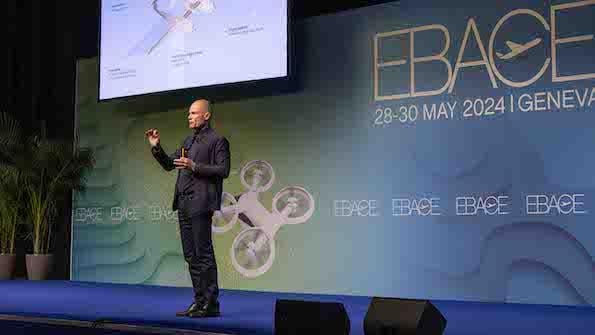'Innovation Comes When We Get Rid Of Old Beliefs,' Bertrand Piccard Says

"How can we make [aviation] different if fuel is the limit?” Bertrand Piccard asked EBACE 2024 attendees.
GENEVA—A record-breaking third-generation aviator, Bertrand Piccard, reflected on his family’s aviation history during the opening keynote session at the European Business Aviation Convention and Exhibition here. Piccard flew nonstop around the world in a balloon in 1999 and made intercontinental flights in the solar-powered Solar Impulse aircraft in 2015-16.
Thus far, EBACE 2024 has displayed a sizable focus on innovation in every aspect of the business aviation industry. Piccard echoed that. “Innovation does not come so much from when we have new ideas; innovation comes when we get rid of old beliefs,” Piccard said.
Piccard’s grandfather, Swiss inventor Auguste Piccard, defied common beliefs to create the first high-altitude hot air balloon and became the first person to enter the stratosphere.
“Before 1930, aviation was limited to unpressurized flights. Airplanes were flying in bad weather; a lot of resistance of the air, so huge fuel consumption, and it was not reliable because of the technology,” Piccard said. “When my grandfather thought: ‘OK, to make it reliable, to make it efficient, we have to pressurize aviation. We have to make a pressurized cabin and fly above the bad weather in thinner air in order to use less fuel,’ everyone thought it was completely impossible, and nobody wanted to build his pressurized cabin.”
According to Piccard, his grandfather enlisted the help of an unsuspecting Belgian beer tank factory to build a pressurized hot air balloon cabin after several rejected requests from other engineers.
“The constructor said: ‘But why these big openings?’ And I think my grandfather said: ‘Well, to clean the inside.’ But it was the porthole and the door. And then it was too late for the guy to say: ‘No, I don’t want to build it,’” Piccard said. “It was already climbing to 16,000 m [53,000 ft.], showing that modern aviation had a future if it was flying higher and more efficient.”
Piccard carries on his grandfather’s legacy in the unique notion of the next era of aviation as one without fuel.
“For 100 years, we’ve had abundant and cheap fuel. Today it’s not exactly like that anymore,” he said. “Aviation, in a way, is in a museum—aviation with fuel. So we have to make it differently now. And how can we make it different if fuel is the limit?”
That line of logic helped Piccard and his team in the design of his solar-powered aircraft, which he flew around the world through a combination of technology and operational techniques.
“We had to climb to 9000 m and then glide down for 4 hr. without engine,” he said. “And then use the battery to reach sunrise. And we could start to recharge the battery and make cycle after cycle.”
Piccard believes this defiance of expectations is key to business aviation’s transition to net-zero carbon emissions.
“We need to restore hope. We need to restore enthusiasm, and we need to show what we can achieve, even if some people believe it’s impossible,” he said. “This is what aviation has to show.”
Piccard’s new project, Climate Impulse, is aiming to fly nonstop around the world in a hydrogen-powered aircraft. He has teamed up with sailor, composites material specialist and test pilot Raphael Dinelli, who is designing the electric aircraft around a fuel cell.





